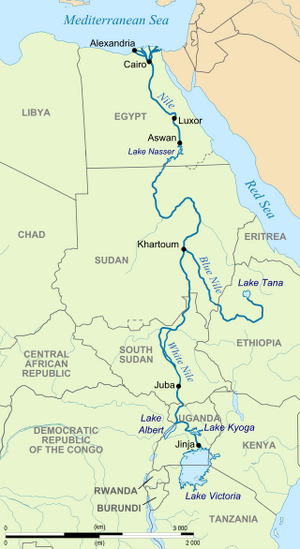Luxor
| Author:Laxman Burdak, IFS (Retd.) |

Luxor (Arabic: الأقصر al-Uqṣur ; Egyptian Arabic: Loʔṣor IPA: [ˈloʔsˤoɾ]; Sa'idi Arabic: Logṣor [ˈloɡsˤor], Coptic: ⲛⲏ) is a city in Upper (southern) Egypt and the capital of Luxor Governorate.
Origin of name
The name Luxor comes from the Arabic al-ʾuqṣur (الأقصر), lit. "the palaces," from the collective pl. of qaṣr (قصر),[1] which may be a loanword from the Latin castrum "fortified camp".[2] (Compare Alcázar of Seville)
History
As the site of the Ancient Egyptian city of Thebes, Luxor has frequently been characterized as the "world's greatest open-air museum", as the ruins of the temple complexes at Karnak and Luxor stand within the modern city. Immediately opposite, across the River Nile, lie the monuments, temples and tombs of the West Bank Necropolis, which includes the Valley of the Kings and Valley of the Queens. Thousands of tourists from all around the world arrive annually to visit these monuments, contributing greatly to the economy of the modern city.
The city attracted peoples such as the Babylonians, the Mitanni, the Hittites of Anatolia (modern-day Turkey), the Canaanites of Ugarit, the Phoenicians of Byblos and Tyre, the Minoans from the island of Crete.[3]
A Hittite prince from Anatolia even came to marry with the widow of Tutankhamun, Ankhesenamun.[4]
The political and military importance of the city, however, faded during the Late Period, with Thebes being replaced as political capital by several cities in Northern Egypt, such as Bubastis, Sais and finally Alexandria.
However, as the city of the god Amon-Ra, Thebes remained the religious capital of Egypt until the Greek period.[5]
The main god of the city was Amon, who was worshipped together with his wife, the Goddess Mut, and their son Khonsu, the God of the moon. With the rise of Thebes as the foremost city of Egypt, the local god Amon rose in importance as well and became linked to the sun god Ra, thus creating the new 'king of gods' Amon-Ra. His great temple, at Karnak just north of Thebes, was the most important temple of Egypt right until the end of antiquity.
Later, the city was attacked by Assyrian emperor Assurbanipal who installed the Libyan prince on the throne, Psamtik I.[6]
The city of Thebes was in ruins and fell in significance. However, Alexander the Great did arrive at the temple of Amun, where the statue of the god was transferred from Karnak during the Opet Festival, the great religious feast.[7]
Thebes remained a site of spirituality up to the Christian era, and attracted numerous Christian monks in the Roman Empire who established monasteries amidst several ancient monuments including the temple of Hatshepsut, now called Deir el-Bahri ("the northern monastery").[8]
External links
References
- ↑ Verner, Miroslav (2013) Temple of the World: Sanctuaries, Cults, and Mysteries of Ancient Egypt Cairo: American University in Cairo Press. p. 232. ISBN 9789774165634
- ↑ Shahîd, Irfan (2002) Byzantium and the Arabs in the Sixth Century Washington, D.C.: Dumbarton Oaks Research Library and Collection. ISBN 9780884022848. page 68.
- ↑ "History of Luxor (Thebes)". Sacred Destinations.
- ↑ "History of Luxor (Thebes)". Sacred Destinations.
- ↑ "History of Luxor (Thebes)". Sacred Destinations.
- ↑ "History of Luxor (Thebes)". Sacred Destinations.
- ↑ "History of Luxor (Thebes)". Sacred Destinations.
- ↑ "History of Luxor (Thebes)". Sacred Destinations.

